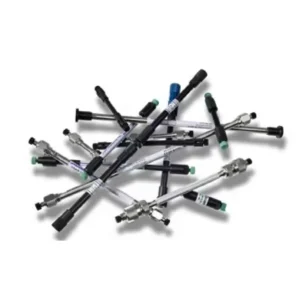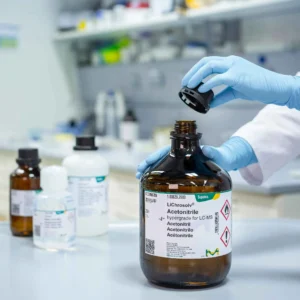UHPLC is The Future for Peptide Mapping
What is Peptide Mapping?
Peptide mapping, also known as protein or peptide sequencing, is a technique used to determine the amino acid sequence of a protein or peptide. It is an essential tool in protein analysis and characterization, particularly in biopharmaceutical, biochemistry and biotechnology.
The process of peptide mapping involves breaking down the protein or peptide into smaller fragments, typically through enzymatic digestion using proteolytic enzymes such as trypsin, chymotrypsin, or pepsin. The fragmented protein/peptide will then be separated by High-Performance Liquid Chromatography (HPLC) or Ultra High-Performance Liquid Chromatography (UHPLC), followed by the determination of molecular weight with Mass Spectrometry (MS). The amino acid sequence of the protein or peptide can be deduced by comparing the experimental mass spectra to a database of known peptide sequences.
Peptide mapping is a valuable technique in various applications, including protein structure determination, protein identification, detection of post-translational modifications (PTMs), and quality control of recombinant protein production. It provides crucial information about the primary structure of a protein or peptide, which is essential for understanding its function and biological activity.
What are HPLC & UHPLC?
HPLC stands for High-Performance Liquid Chromatography, while UHPLC stands for Ultra-High-Performance Liquid Chromatography. Both are analytical techniques used to separate, identify, and quantify components in a mixture based on their chemical properties.
Both involve the use of a liquid mobile phase (solvent) that carries the sample through a column packed with a stationary phase. The sample is injected into the system, and as it flows through the column, different components interact with the stationary phase to varying degrees. This differential interaction leads to separation based on factors such as polarity, size, charge, or hydrophobicity. While HPLC and UHPLC share the same fundamental principles for component separation, they differ in several aspects, as outlined below:
| HPLC | UHPLC | |
| Particle Size | Larger particle sizes, typically ranging from 3 to 5 μm in diameter | Smaller particle sizes, typically ranging from 1.7 to 2.5 μm in diameter |
| Pressures | Lower pressure, 4000-6000 psi | Higher pressure, 10,000-15,000 psi |
| Flow rate | Slower | Faster, reduces analysis time while maintaining or improving separation efficiency and resolution |
| Efficiency | Lower | Higher efficiency and better separation |
| Sensitivity | Lower | Higher |
| Surface area of particles | Lower | Higher |
In summary, while both HPLC and UHPLC are liquid chromatography techniques used for separation and analysis, UHPLC offers enhanced performance with faster separations, higher resolution, and improved sensitivity due to the use of smaller particle sizes and higher operating pressures.

Example of UHPLC Column
Advantages of Using UHPLC in Peptide Mapping
Improved Speed and Throughput
UHPLC techniques offer significantly faster separations compared to traditional HPLC methods. With smaller particle sizes and higher operating pressures, UHPLC systems can achieve higher flow rates and shorter analysis times, leading to increased sample throughput.
Enhanced Resolution and Sensitivity
The use of UHPLC columns with smaller particle sizes allows for improved separation efficiency and higher resolution. This results in sharper and better-separated peaks, enabling more accurate identification and quantification of peptides in complex mixtures. Additionally, the increased surface area of the stationary phase in UHPLC columns enhances sensitivity, allowing for the detection of low-abundance peptides.
Higher Peak Capacity
UHPLC systems can achieve higher peak capacities, which means they can separate a larger number of peaks within a given time frame. This is particularly advantageous for complex peptide mixtures, where a higher peak capacity allows for better characterization and analysis of the components.
Reduced Solvent Consumption
UHPLC methods typically use smaller column dimensions and operate at higher flow rates, leading to reduced solvent consumption per analysis. This can result in cost savings and reduced environmental impact associated with solvent waste.

Example of Solvent Used for HPLC/UHPLC
Drawbacks of Peptide Mapping using Traditional HPLC
Time-consuming
Traditional HPLC methods for peptide mapping can be relatively time-consuming, especially when analyzing complex protein samples. The separation and analysis of peptides can take a significant amount of time, leading to slower overall analysis and lower throughput.
Limited resolution
Traditional HPLC columns with larger particle sizes have limitations in providing high resolution for complex peptide mixtures. This can result in overlapping peaks and reduced separation efficiency, making it challenging to accurately identify and quantify individual peptides.
Conclusion: Peptide Mapping using UHPLC is the Future!
Overall, peptide mapping using UHPLC offers improved speed, resolution, sensitivity, and peak capacity compared to traditional HPLC methods. These advantages make UHPLC a valuable technique for the efficient and accurate analysis of peptides in various research, pharmaceutical, and biotechnological applications.

